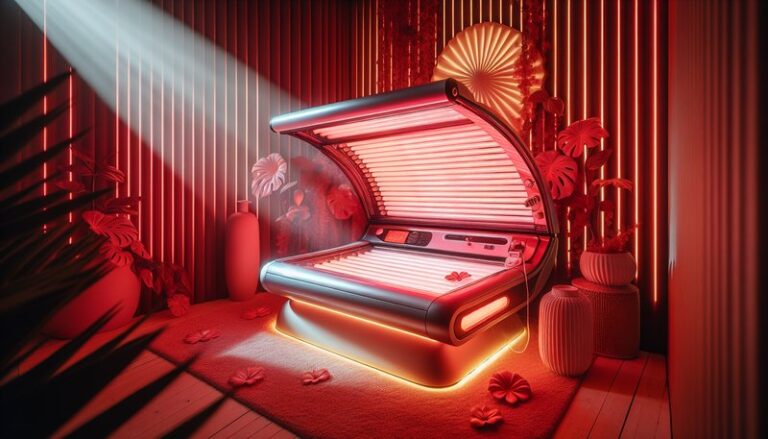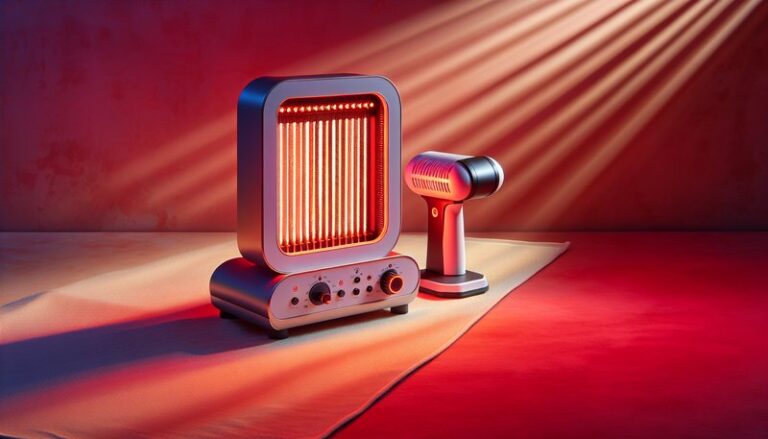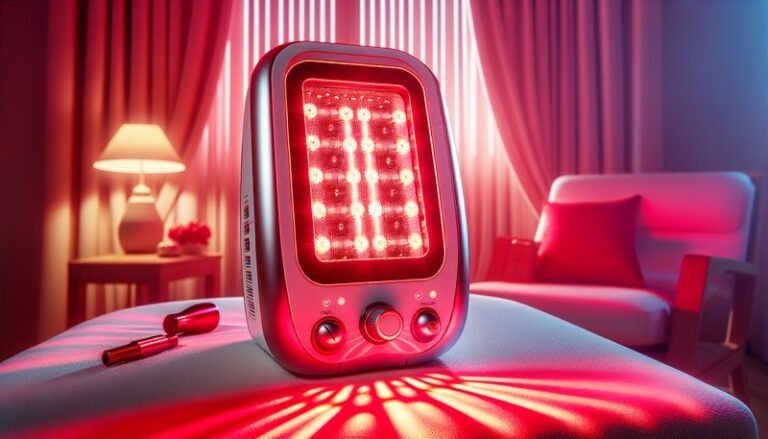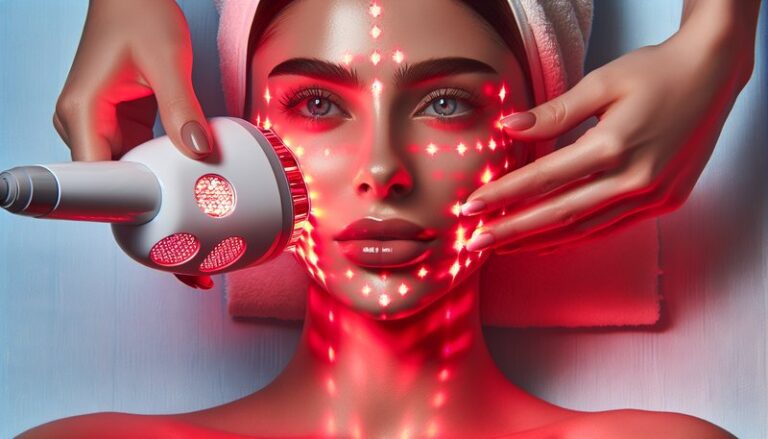Does Red Light Therapy Help Depression?
Are we overlooking an unconventional solution for mental health struggles?
Explore DIY Red Light Therapy
Check our latest on Is Red Light Therapy Safe for Thyroid?
This article delves into the intriguing topic of red light therapy and its potential benefits for individuals dealing with depression. We will explore the mechanism behind red light therapy, evaluate its effectiveness, and consider alternative treatments as well as essential factors to weigh before starting this therapy.
Key Takeaways
- Red light therapy may positively influence mood and reduce symptoms of depression through its effects on the brain and circadian rhythms.
- While promising, further research is needed to determine the long-term efficacy and safety of red light therapy for depression.
- It’s important to consult with a mental health professional before incorporating any new treatment into your care regimen.
What is Red Light Therapy?
Red light therapy (RLT) involves the use of low-wavelength red light to stimulate various biological processes in the body. Originally developed for treating skin conditions, it has gained attention for its potential to improve mood and mental health. RLT operates on the principle of photobiomodulation, where specific wavelengths of light can penetrate the skin and influence cellular activity.
Mechanism of Action
RLT works by targeting the mitochondria in cells, which play a crucial role in energy production. By boosting mitochondrial function, red light can enhance cellular metabolism, reduce inflammation, and promote healing. These interactions may also extend to brain cells, influencing neurotransmitter levels, including serotonin and dopamine, which are critical for mood regulation.
Applications Beyond Depression
In addition to its effects on mood, RLT is being studied for various applications, including pain management, wound healing, and skin rejuvenation. This broad range of benefits underscores the regenerative potential of red light therapy.
What are the Benefits of Red Light Therapy?
When considering red light therapy for depression, several potential advantages come into play. The following benefits highlight why this therapy may be valuable:
Improved Mood Regulation
Research suggests that RLT could help regulate mood by increasing serotonin levels, which has a direct impact on feelings of happiness and well-being. Anecdotal evidence and preliminary studies indicate significant improvements in mood among individuals undergoing this therapy.
Enhancement of Sleep Quality
Quality sleep is integral to mental health. RLT has been shown to positively influence circadian rhythms, which could lead to improved sleep patterns. Better sleep can alleviate feelings of fatigue and irritability commonly associated with depression.
Reduction in Inflammation
Chronic inflammation has been linked to various mental health disorders, including depression. RLT may possess anti-inflammatory properties that could contribute to an overall reduction in inflammatory markers in the body, promoting better mental health outcomes.
Non-Invasiveness and Safety
RLT is generally considered safe and non-invasive, making it an attractive option for those hesitant about more aggressive treatments. Side effects are minimal and typically non-existent, especially when compared to pharmaceuticals.
Potential for Combining Therapies
RLT can be used alongside other treatment modalities, such as psychotherapy or medication, potentially enhancing overall effectiveness without interference.
Is it Possible to Incorporate Red Light Therapy into Your Treatment Plan?
Yes, incorporating red light therapy into a treatment plan for depression is feasible. Many people are drawn to the idea of an alternative therapy, particularly one that offers a non-invasive approach to managing their mental health.
What are the Advantages of Incorporating RLT?
Such a decision comes with its own set of benefits:
Accessibility
RLT devices are becoming increasingly accessible for home use, allowing individuals to integrate therapy into their daily routine without needing frequent visits to a clinic.
Customization
Sessions can often be tailored to the user’s needs, with adjustable settings related to duration and intensity, ensuring a personalized treatment experience.
Holistic Approach
Incorporating RLT fosters a holistic approach to mental health, combining physical wellness with mental health strategies for more comprehensive care.
Affordability
For many, RLT may be a more affordable long-term investment compared to continuous medication or psychotherapy sessions.
What are the Disadvantages of Incorporating RLT?
While RLT is promising, it’s essential to consider some potential drawbacks:
Lack of Regulation
Currently, the markets for at-home RLT devices are minimally regulated, leading to variations in effectiveness and safety. Users should be cautious and research devices thoroughly before purchasing.
Limited Research
Despite the existing studies, more extensive and rigorous research is necessary to fully validate the efficacy of RLT for treating depression before it can be universally recommended.
Time Commitment
Implementing RLT into your routine may require a commitment of time, as regular sessions (often several times a week) are recommended for optimal results.
What are the Things to Consider Before Incorporating RLT?
Before starting red light therapy, several important factors should be evaluated:
Consultation with Health Professionals
Before beginning treatment, individuals should consult with mental health professionals. This ensures that RLT is suitable for their specific situation and is used in conjunction with other prescribed treatments.
Setting Realistic Expectations
Users should enter into the experience with realistic expectations, understanding that while RLT may help, it is not a magic cure and should be viewed as part of a broader treatment strategy.
Device Selection
Choosing the right device is crucial. Researching the quality and safety of different products is essential to avoid subpar results.
What are the Alternatives to Red Light Therapy?
If red light therapy does not seem like a good fit, other treatments for depression are available:
Cognitive-Behavioral Therapy (CBT)
CBT is a well-established form of psychotherapy that helps individuals identify and reshape negative thought patterns, effectively improving mood and behavior.
Medications
Antidepressant medications can help manage symptoms and restore balance to neurotransmitter levels in the brain. Consulting with a psychiatrist can provide guidance on appropriate medication.
Exercise
Regular physical activity is proven to have antidepressant effects, enhancing mood and reducing feelings of anxiety. It can be a crucial component of a multifaceted approach to treatment.
Mindfulness and Meditation
Practices such as mindfulness and meditation can help reduce stress, promote emotional regulation, and contribute to overall well-being as part of a comprehensive mental health strategy.
Conclusion: Is it Recommended to Incorporate Red Light Therapy?
In summary, red light therapy presents a promising and innovative avenue for supporting individuals coping with depression. However, as with any treatment, it should be pursued with caution and ideally integrated within a broader treatment framework under professional guidance. For those curious about this therapy, discussing its potential with a healthcare provider can help make an informed decision based on individual needs.
Frequently Asked Questions
Is red light therapy scientifically proven to treat depression?
While initial studies and anecdotal evidence are promising, more rigorous scientific research is required to establish conclusive proof of its effectiveness for depression.
How often should I use red light therapy for depression?
Most recommendations suggest using RLT 3-5 times a week; however, individual needs may vary, so it’s best to follow the guidance of a healthcare professional.
Are there any side effects from red light therapy?
RLT is generally considered safe with minimal side effects. Some users may experience skin irritation or discomfort, but these are rare.
Can I use red light therapy with other treatments?
Yes, RLT can be incorporated with other treatments like medication and therapy to enhance overall mental health support.
What should I look for when choosing a red light therapy device?
Choose a device from a reputable manufacturer, ensuring that it emits the correct wavelengths of light, and read reviews to assess user satisfaction and effectiveness.





